#category: scholarships
Note
theres a race section on american transcripts????
for my education transcript personally, as far as i know, yes :(
#they make you mark down your race#options are: white. black. hispanic/latino. asian. native american. other.#💀 and then in parentheses they write “if you are from middle eastern origin mark down white”#like bruh what if someone of “middle eastern origin” was brown 😭 what then#my brown grandpa and his entire family would NOTTTTT mark down white 😭#and i can't put asian because they are referencing to east asian. and i am FAR south west asian. smh#i assume they put down race on transcripts because in highschool or college you can win certain scholarships if you're black or native. etc#but yeah it's annoying seeing people put into categories that don't even make sense
25 notes
·
View notes
Text
Historical writing nevertheless continued, taking new forms and developing old ones. Probably the form of written narrative most commonly associated with the period 500–700 is so-called ‘national history’: Jordanes’ Getica (mid-sixth century), Gregory of Tours’ so-called History of the Franks, Isidore of Seville’s History of the Goths, Sueves and Vandals, of the early seventh century, Bede’s early eighth-century Ecclesiastical History of the English People, and Paul the Deacon’s History of the Lombards (late eighth century), to which one should add the anonymous early eighth-century Liber Historiae Francorum, the early ninth-century History of the Britons attributed to Nennius and the late ninth-century Anglo-Saxon Chronicle, and other works. Most of these works were written after the close of the time-span covered by this volume but, as they claim to relate the history of our period, they deserve treatment here. These sources were at first considered to be repositories of the age-old traditions of the different peoples of early medieval Europe. Since, in the nineteenth and earlier twentieth century these peoples were regarded as distinct racial units, in line with the ideas of the nation-state developed at that time, such works were seen to represent the foundations of the histories of modern European nations, their authors portrayed as the founders of national historical traditions. The information they contained was held to be reliable, transmitted down the generations, it was assumed, by oral tradition. As attitudes towards the nature of the barbarian ‘peoples’ themselves changed, so the ways in which these sources were viewed changed too. Most have been the subject of intense debate. The nature of Jordanes’ history has come under close scrutiny, and Gregory of Tours’ writing has become the focus of an even larger field of profitable debate, hardly any of which now sees his writings as forming any sort of ‘History of the Franks’ (as discussed above). Meanwhile, controversy has been provoked by the interesting suggestion that Paul the Deacon’s History of the Lombards might have been composed for a Frankish audience. The other sources have also attracted debate and revaluation.
Not only are many of these works no longer seen as ‘national histories’, it is also recognised that they may represent instances of other genres entirely: the Anglo-Saxon Chronicle, obviously enough, takes the form of a set of annals (Isidore’s History is also written to an annalistic structure); Bede’s is an ecclesiastical history; and so on. Gregory’s, as mentioned, was not written as a national history at all, though quite which – if any – genre Gregory was composing in is a matter of debate. At the same time, the purposes to which these sources were put, using the past to serve political needs of later centuries, were also served by works of many other kinds, never viewed as particularly ‘nationalistic’. The lesson of the scholarship of recent decades has essentially been that to understand these sources they have to be replaced in the contexts of their composition. The political motives behind their composition make them far more contingent, and concomitantly far less valuable as treasuries of ancient fact, than hitherto believed. At the same time, however, they become very valuable sources for the examination of the political culture and ideology of the times and places where they were written: mid-sixth-century Constantinople; early seventh-century Spain; late ninth-century Wessex, for example. These lessons apply to most other sources written in our period.
Guy Halsall, ‘The sources and their interpretation’ from The New Cambridge Medieval History, vol. 1: 500-700
#currently reading#by and large this is 101 Critical Source Analysis but: always helpful 2 remember how much 19/20th century scholarship constructed discrete#racial categories out of these works & the legacy of such a construction continues into the present day
72 notes
·
View notes
Text
will graham is, how you say, "just like me for real" ?
#me when i **** *** and want to **** ** ****** just to ** **** **#^ nobody is going to decode that but it's a category 10 will graham s3 esque yearning moment... anyways#should i spend my spring semester in europe next year (if finances n scholarships allow)#sighhhh if i ever fell in love again i don't know if i would get married but i would explore florence with them n sit at uffizi gallery#i would visit the hannibal mind palace church... take care of them... look at beautiful art... draw portraits of them in charcoal... etc#not yearning for anyone in particular but i neeeeeed closeness and intimacy in my life oh mein gott
2 notes
·
View notes
Text
How to get fully funded scholarships for Indian students
Unlock a world of possibilities with fully funded scholarships for Indian students! Explore exciting educational opportunities and financial aid programs designed to support talented individuals in pursuing their dreams. Don't miss out on this chance to secure your future without worrying about tuition fees. Start your journey towards academic excellence today
0 notes
Note
Lestappens one sided beef is giving one of those reddit posts titled smth like-
"TIFU by finding out that apparently me and my academic rival have been dating for the past 10 years"
"In my defence I 25M just thought that we were in a really intense fight to get that scholarship and didnt consider the fact that all of those 'intellectually nourishing' outings we had were just... dates'
AU where Max never publicly dates until one day he mentions “my boyfriend Charles” in an interview after his third championship win and everyone, Charles included, has a category 5 meltdown. Silvia locks Charles up in Maranello while Charles protests “I DIDN’T EVEN KNOW WE WERE DATING”. A follow up interview with Max has him saying that they’ve been together for years. Chaos ensues.
309 notes
·
View notes
Text

New Scholarships by Twinsimming 🎓
"Need some extra simoleons for university? Sims University now offers a variety of scholarships for prospective students!"
This is a script mod that can be placed in your Packages folder. It was built and tested on 1.69 but should work fine on 1.67.
Requirements
To access all of the scholarships available with this mod, the following packs and store content are required:
The Sims 3: World Adventures
The Sims 3: Ambitions
The Sims 3: Generations
The Sims 3: Showtime
The Sims 3: Supernatural
The Sims 3: Seasons
The Sims 3: University Life
The Sims 3: Island Paradise
The Sims 3: Into the Future
Fit As a Fiddle Violin (The Sims 3 Store)
Artisan Glassblowing Station (The Sims 3 Store)
Stiff as a Board, Light as a Feather Dance Floor (The Sims 3 Store)
Overview
Applying for Scholarships
Types of Scholarships
Maintaining Scholarships
New Moodlets
Online Aptitude Test
New Cheat
Applying for Scholarships
Teen sims and older have a new “Apply for Scholarships” interaction available at the school rabbithole or on the computer under “Sims University Online”. Though they’re less likely to win a scholarship if they apply online rather than in person.
If your sim wins a scholarship, they will not be able to reapply for that scholarship again. If they do not win, they will be given a Disappointed moodlet and have to wait a day before applying again.

Types of Scholarships
There are four (4) types of scholarships your sims can apply for: General, Legacy, Skill Based, and Occult. In total, there are 18 scholarships, each with their own custom moodlet.
Sims have a 45% chance of winning a scholarship in the General, Legacy, and Occult categories when applying in-person and a 40% chance when applying online.
Sims have a 6% chance of winning a Skill Based scholarship at Level 1 of the required skill. This chance multiplies with each skill level, with a maximum of a 60% chance at Level 10.
Certain traits can either increase or decrease your chance of winning a scholarship by 5% (note: this value stacks the more traits your sim has):
Increased Chance Traits - Lucky and Ambitious
Decreased Chance Traits - Unlucky and Loser
Some of the scholarship names are originally from The Sims 2 and the others I made up myself. They are listed below by category:
General
Young Entrepreneurs Award (§750) - Requires Level 3 part-time job, Teen only
Orphaned Sims Assistance Fund (§750) - Requires deceased or non-existing parents, Teen only
Golden Year Scholars Grant (§1000) - Elders only
Gemini Hidden Masters Prize (§1500) - Requires Level 10 in one hidden skill
Legacy
Student Service Workers Fund (§1000) - For sims with a service worker hidden trait (Makes No Messes, Pyromaniac, Can Apprehend Burglar, Can Salute, Immune To Fire, or Pizza Appreciator)
Cultural Exchange Program (§1000) - For sims with one of the hidden culture traits from The Sims 3: World Adventures
Students of Tomorrow Scholarship (§1000) - For sims with the hidden Future Sim trait from The Sims 3: Into the Future
Skill Based
Dreamer Family Artisan Award (§750) - Requires at least Level 1 Artisan Skill
Tsang Footwork Award (§750) - Requires at least Level 1 Dance (Store) Skill
Violin Society of SimNation Scholarship (§750) - Requires at least Level 1 Violin Skill
Occult
Undead Education Scholarship (§1500) - For Vampires, Zombies, and Ghosts
Extraterrestrial Reparation Grant (§1500) - For Aliens and sims recently abducted by Aliens
Spellcasting Scholars Grant (§1500) - For Witches, Fairies, and Genies
Lycanthropy Philanthropy Fund (§1500) - For Werewolves
Bots Opportunity To Specialize (B.O.T.S.) (§1500) - For Simbosts and Plumbots
Forbidden Fruit Fellowship (§1500) - For PlantSims
Real World Acclimation Fund (§1500) - For Real Imaginary Friends
Aquatic Allies Award (§1500) - For Mermaids

Maintaining Scholarships
After winning a scholarship, your sim will get the new custom Won Scholarship moodlet. They have a week to either enroll in online university with my Attend University Online mod, or in-person university to remain eligible for their scholarship.
If they fail to enroll in time, their scholarship will be rescinded and they will have to pay back the money they were awarded. If they can’t afford to pay back the scholarship amount in full, it will be added to their next household bill. (No free money here!)
Once a sim has a scholarship rescinded, they will get the new custom Lost Scholarship moodlet and be barred from applying for scholarships for 3 days.
New Moodlets
Won Scholarship: Given when a sim wins a scholarship, lasts 1 day, +20 mood, each scholarship has its own custom moodlet icon
Lost Scholarship: Given when a sim has a scholarship rescinded, lasts 3 days, -20 mood, makes sims stressed
Online Aptitude Test
Teen sims and older can now take the university aptitude test on the computer under “Sims University Online”. It works the same as the default interaction.
Tuning
All of the tunable values can be found on the mod download page under the header “Tuning”.
New Cheat
If you want to clear all scholarship winners in your world (on a per save basis), enter the cheat menu and type “ClearScholarshipWinnerData” without the quotation marks.
Conflicts & Known Issues
This is a new script mod so there shouldn’t be any conflicts.
Credits
EA/Maxis for The Sims 3 and The Sims 4, Visual Studio 2019, ILSpy, s3pe, Notepad++, and Script Mod Template Creator.
Thank You
Thank you to gamefreak130, Battery, @zoeoe-sims, @greenplumbboblover, and @monocodoll!
If you like my work, please consider tipping me on Ko-fi 💙
Download @ ModTheSims
611 notes
·
View notes
Text
As neoliberalism has infected higher education, research on "mental health issues" in the academy has become increasingly conservative. My own subject area, sociology, is as guilty as any other. We have lost sight of what it means to think critically about the mental health system, to be able to challenge the work of the psy-professions, to interrogate meaningfully the production of knowledge claims on "mental disease," and to adequately contextualise the expansion of the psychiatric discourse with reference to theoretical sets of ideas which refer to labelling, power, and social control. We have effectively become pseudo-social psychologists whose research agenda is passed down to us by state agencies, requiring us to do little more than identify marginalised groups who can be labelled and policed by the psychiatric authorities and the criminal justice system. Having a once proud tradition of highlighting the systematic, oppressive practices of the mental health system, the sociology of mental health is now in severe danger of simply becoming another arm of the state. Far too much of what passes for "research" in the discipline is flawed from the beginning: it takes for granted that the mental health system is a fundamentally caring, scientifically sound discipline; it accepts mental illness diagnoses as valid and having a proved aetiology; and the empirical lens is focused outward on "undetected" pathologies in the general population rather than inward on the pathological behaviour of the institution of psychiatry and its allies. The result is that we end up with sociological research and scholarship which perpetuates the myths of psychiatric knowledge and aids the expansion of psychiatric hegemony (how many times have we read at the conclusion of such articles and books that there is a gap—an "unmet need"—in current mental health provision for which further resources and staffing is required?).
Thus, we need to resist the top-down state-run agenda and reject funding streams that tie us into conservative, surveillance-focused projects. We also need to be vocal in challenging the scholars who take on such projects and reproduce the same old nonsense on mental illness prevalence which reinforces the hegemonic view of black, female, young, LGBT, working class, and other marginalised populations as pathological. As always, sociological investigation needs to focus on the powerful rather than the powerless. This requires the revitalisation of a truly critical research agenda for the sociology of mental health in which the operations and practices of the psy-professions and their production of knowledge claims are prioritised. Research would then focus on the politics of diagnostic construction and professional power, on how psy-professionals turn subjective, personal understandings of human beings into categories of pathology, on the inner workings of the mental health system, on the conflicts and alliances made internally and externally to these professions, and on their constant need to justify mental health practice as medically and scientifically relevant.
Bruce M.Z. Cohen, Psychiatric Hegemony: A Marxist Theory of Mental Illness
221 notes
·
View notes
Text
However, scholarship on the history of the body has shown that sexual dimorphism may not have always underpinned scientific or religious thought. (4) In the field of Islamic history, Indira Falk Gesink argues that despite the importance of a gender binary to the realms of marriage, the household, inheritance, and ritual, Muslim scholars from across the spectrum of premodern jurisprudence exhibited flexibility when confronted with morphological ambiguity. They adopted a category of “complex sex” and allowed people to hold different sex designations simultaneously or to pass from one to another. (5) Medieval Arabic medical texts go a step further and elaborate what Ahmed Ragab calls a “sexscape” in which bodies were observed and placed along a continuum from ultramasculine males at one extreme to ultrafeminine females at the other, with plenty of options in between. Although these texts predictably focus on anatomy and morphology, they deemphasize genitalia, at least in comparison to other physical markers, in locating a body on the continuum. (6) This scholarship highlights the inadequacy of a binary construction of sex for understanding the way bodies were perceived and positioned in premodern legal and medical discourses.
Zayde Antrim, “Qamarayn: The Erotics of Sameness in the 1001 Nights” in Al-Usur Al-Wusta
#bookreading#i need an academic reading tag#gender#sections bolded for emphasis/readability as always
1K notes
·
View notes
Text
001. 𝐌𝐔𝐒𝐓 𝐁𝐄 𝐅𝐔𝐍𝐍𝐘 𝐈𝐍 𝐓𝐇𝐄 𝐑𝐈𝐂𝐇 𝐌𝐄𝐍'𝐒 𝐖𝐎𝐑𝐋𝐃


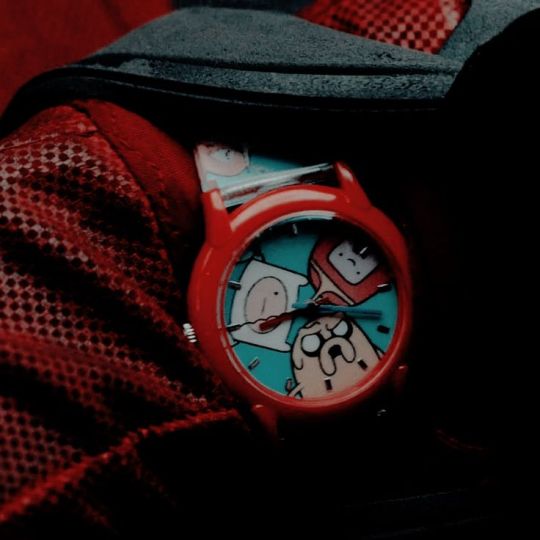
MASTERLIST. ! <- 001. -> 002.
warnings: mentioning of guns and weapons, blood, reader has some PTSD, minho calls reader pet names.
words count: 3.8k

There are two types of people in the world: those who support heroes and those who believe they only bring chaos to the city.
You are not part of any of these categories.
You don't care about heroes, your life in a tiny apartment in Manhattan has never changed thanks to them. Your small business as a Pizza's restaurant in one of the quietest neighborhoods of New York hasn't paid off thanks to them.
You're just there, waiting for the big event in your life. Until then? you just pass your time listening to some cheap music from your dad's radio.
"Y/n, vien qua, c'è gente!"
Your father's voice wakes you up, his strong Italian accent stops your music and put your headphones down from your head, the song still playing on your phone but you can't look or stop right now. You have to go back to work.
Your family runs a little business, your father works in the kitchen - cooking pizza with the true receipt from Italy. Your mother on the other hand get ready some typical desserts, like tiramisù, panna cotta and even gelato. Your grandma stays the whole day in the same spot, with her purple shawl on her shoulders, her glasses falling to the tip of her nose, her eyes on some Hispanic soap opera and her puzzle week.
You, just work as a cashier, giving them a little help when you're off from University. You got into a really expensive place, with people that have been spoiled their entire life, you just learned in another way the meaning of money.
Your grandmother came to the US when she just turned 25, in one hand she had her suitcase, in the other one her dreams. Learning English from the scratch, with three jobs part-time and her husband with two more jobs. They had a simple, chaotic but happy life. Until your grandfather passed away, leaving your dad the small business that they started on their own after saving the few pennies set aside.
You can't actually understand why they bought the place so far away from Little Italy, closer to Time Square than the rest of the really famous restaurants. Every time you ask to your grandmother, she just justifies herself saying, "your nonno was really stubborn".
Your grandfather, really thought that was the best option, with an apartment include with the small place for the 'sliced pizza's business', enough room for you and the rest of your family.
You know the place isn't very successful, there are few regulars, just enough to make reaching the end of the month with the end-of-month expenses. You know you can't ask for too much, and your college grades must remain impeccable to continue receiving the scholarship. Everyday you think how lucky the other people are, not really knowing their story, but just the fact that during your uni lessons they can normally say things such as 'let's go to a karaoke after this', makes you jealous.
You're not popular, you're not rich.
That cut a lot of your social life, but not enough to not have any friends. As you walk out the back of the restaurant to get in the cashier spot, you can see your best friend with a big smile in her face, waving at you. "Yo mama is fine as hell."
You can't contain a laugh, her obsession with milfs and girls in general always finds the way to change your mood, your hand on your abdomen makes her laugh too. "What are you looking for today?"
"Some girls to kiss, wanna be the next one?"
Her cheeky pick-up lines never failed of making you smile, you start to count the price for two slides of pizza, "it's 3 dollars," she hisses as she takes out her wallet from her expensive bag, "if I really have to."
You chuckle as you grab the three banknotes from her hand, her smile makes you smile. And for a moment, you're really happy. No worries, no thoughts. For a single second, your life is not that miserable as you think.
Until.
Until you can hear screaming, glass that breaks and terrifying looks in the faces of the people that you love. You never imagined that your life can change in an amount of seconds, when you can see a dark red costume. With weapons on his back and a gun in his hand.
You are not a big nerdy, but you know for sure that this costume it's just for one person only, Deadpool. He's not a hero, he's not a villain, he defines himself to the police as 'cleaner of shit from the others'.
He's basically hitman, that if he is not forced by the person from whom he takes the task, he would not kill. And inside you, as you hide behind the counter while your heart shatters your chest, your hands shaking and the blood buzzing in your ears; you pray that it will be so.
You pray that he's in the wrong place, that he's just in the wrong place at the wrong time, but the direction he's pointing is in the kitchen. You feel your blood almost stop pumping in your heart, you can feel a a presence so gloomy that you can only hide more under the counter.
"No! please!"
Your mother's voice wakes you up and you stand up from your spot, your best friend is taking care of your grandmother that fell from the chair, you can feel your eyes watering, but you try your best to push them back for later. Before you can even step inside the kitchen, a shotgun pierces the screams. The silence.
You never thought you could hate silence more than now, you run into the kitchen, your mother on the floor crying as your dad is moaning in pain, the chest wound fills the floor with blood. Deadpool currently cleans his gun with the towel your mother usually keeps on the counter. Tears burst and fall down your face, anger raging inside you.
"I didn't kill him."
The antihero speaks as he walks past you, almost as if nothing had happened. his mask is raised to his mouth as he chews on a piece of pizza. "Easy, blondie."
The siren of the police starts to reach the place, that now is a mess. It's just about of time, and you pray every single one. The floor has pieces of glass from the windows, the chairs and tables overturned, the TV that your grandmother usually watch during the day is on the floor. Still working, shows the reporters right outside your business place, suddenly Deadpool throws one of his katanas, breaking perfectly the screen.
"Damn I always hated the reporters."
His voice, it's deep, makes you shiver as you get close, but you don't reach his body because one of his guns, it's pointing at your forehead now. You stopped moving.
His chewing sounds fill the place, the only other thing that you can hear it's your dad moaning in pain and your mother crying. "Don't step too close blondie, you're gonna get hurt to try dancing with the evil."
Your breath catches in your throat when he turns his head toward you, you freeze, you can barely speak, "why did you do this? why to us?" It sounds shaky, as he gets too close for your eyes to keep on him, his cologne gets in your senses.
"I just follow work sweet thing, grow up with that."
His voice sounds so mean, it makes you shiver from head to toe, you don't see his eyes, his mask drops covering his face before you could spare a few seconds off his half face.
His tone becomes playful again as the police point guns at you, windows are blown up, letting the spring wind dust off the floor.
That was the first time, that you ever met Deadpool.

Lee Minho feels like heavy rain.
The heavy rain after a thunderstorm, the summer rain, that gets into your bones, making you feel the heaviness of your clothes against your body, your shoes soaking wet and your hair all attached to your neck. That heavy rain.
You don't know if it's because of his charm, or the fact that he doesn't let anyone get too close to him, but something in him makes you feel attracted. Since the first day of your University, your eyes were fighting you to look away from him, his features. You don't even know how his voice sounds like, not even the color of his eyes, it's the classic guy that you keep looking for in a room full of loud people.
His copper red hair that sprouts the hood of the hoodie, with a backpack on the shoulder makes its way to the corridors. He never looks at anyone in the eye, you don't even understand why he's in that institute, is difficult for you to imagine him as a spoiled child. Maybe is that the reason why you find him so charming. No one really knows how he can afford a university like this. A thing that you're sure about Minho and his student career is that he doesn't care about his grades, because he is too smart to study, he leaves the room when he feels bored and the professors never stopped him. He's just, the genius in the class, but anyone really cares, they know that he's too smart for them too. No one has ever beaten him on tests and assignments. Always on time with the deadlines, making him look almost too good that it bothers.
At least, that's what you thought, now after your father got arrested you can't even step inside a class without feeling your skin burn at the sight of the windows, scared for your life that suddenly they can break like that day. Your usual sit it's right next a big window, where your desk is with all the little draws on the top, but not today.
Not today because that seat it's already taken, taken by Lee Minho.
You can feel your cheeks getting warm up, that has been your seat since the year of the semester. Everyone knows that's your seat.
"Excuse me?"
You try to sound as gentle as possible as the guy that is writing in his notebook, his eyes still down, doing some tricks with the pen as he doesn't dare glancing up at you. "Sorry, uhm?"
Minho sigh as you don't move away from his side, standing right next the table that he chose, he takes a deep breath as he turns his face to look at you. It's the first time that you can see his eyes, that are a dark brown, the definition of heavy rain that you gave to him the first day that you saw him feels exactly like his eyes. Cold, his eyes are cold. "What?"
"That's my spot," you point lightly at the table, where his stuff are already placed, and Minho does not like moving around when he finds his spot. He's like a cat, it's hard to make him move from his new favorite angle of the room, "No it's mine." The whole conversation is too childish for you to talk back.
You can feel your cheeks warm up because his voice is firm, making you almost trip in your words as you turn in your feet to find another table, part of you it's a relief. Because your seat it's right beside the window, and being that close to them would make you panic, but of course; Minho doesn't know that.
Or that's what you think.
˚ ✦ . . ˚ . . ✦ ˚ . ★⋆.
For the entire week, Minho took your spot, you didn't know why and he's not that close to anyone to actually ask and know the reason, you just.. accepted. Who are you to tell him what to do?
Every morning - you're not sure how long ago that started but however - you passed there to greet, and leave a juice jug that you bought the machines, nobody had ever approached him like this. You knew you were not special from the others, but you were pleased to see how Minho after about ten seconds that left the juice on the table, smiled by raising just the corners of the mouth. That made you feel good.
The following Monday, Minho is not there, he is never late, which makes you worry. Not that you are friends or more, but that situation was created where you feel you are the duty to.. understand, to know why it is not there.
"Do you know where Minho is?" murmurs to your friends, that are just talking to each other about the last assignment that was hell on earth, your head is in your hands as you look around, your eyes are just looking for one person ad one only.
"y/n, why are you so interested in him?"
Your expression is pure surprise as you look up at your friend, "me? uh, no reason?" You can't lie when your cheeks are getting red just to think about the man that is living in your mind rent free.
"you keep asking about him today! and murmuring stuff, do you have a crush on him?"
Their sudden questions makes you close yourself a little in your thoughts, is really like that?, you're not sure, you never named what you felt for Minho before. You just, let it happened, you can't control your feelings. You can hear the door slamming against the wall, shaking the windows a little and that makes you shake silently.
Minho enter into the room, surrounded by silence, no one says a single thing. 'Cause his face is covered in wounds, a split lip and a cut to his eyebrow, you feel dizzy at the sight.
"What do you have to look at?"he spits out like he's surprised that everyone is paying attention to him now, they never have before.
But he's hurt, and you can't stand it, you can't stand of the sight of more people hurt. You almost jump off the chair where you're sitting, making a really high pitch sound with it on the floor, now the attention it's all around you. Your friends murmur something to convince you to sit back but you can't.
Your eyes are locked in his. You can see his surprise of seeing you standing up for him even if he's not moving any muscle of his face. He knows that you care. More than everyone else.
Your walk is the only sound that the room can hear, your mind keeps whispering: don't do that, don't do that, don't do that. You never skipped a lesson, you never put yourself in trouble, you are always the perfect student.
Oh, fuck it.
You grab Minho's hand, he hisses at the feeling of his hand against yours, the skin it's almost burning for the feeling that makes his cheeks red up, but he doesn't want to admit it. You guys walked out of the class, his eyes on you are making you feel so stupid right now.
"what do you think you're doing?" he mumbles letting his hand grab tighter around yours, he's complaining but he's not letting you go.
You just let yourself go to the nursing room, opening the door nd making him take a seat in one of the beds, "let, let me take a look." You try to move away from him but his hand it's still holding yours tight, your breath catches your throat as you take a deep breath, his thumb passing against your knuckles.
He lets you grab some bandages and disinfectant for the cut on his lip, you stand right in front of him, he moves his thighs spread to let you get closer. His hands finish to play with the edge of your skirt, feeling your whole body shakes a little. You can't stop yourself from crying at his injuries, your hands touch his face so gently that he's surprised too.
Minho chuckles as he looks over you his eyes are gentle, feels more warmer than the first time that they ever made eye contact, "why are you crying blondie?"
The nickname makes you chuckle, he's not gonna be the first one to call you like that, and he's never gonna be the last one. "nothing I, I don't like when people I care gets hurt," you sniff and he stays silent, you can't read his face, you never did.
"what happened? if I can ask," for the first time, Minho seems really interested in what you're about to say, so you just let your thoughts speak. "two months ago, my dad's business got under attack from a hero, he stabbed my father and then he left letting him go away with the police, seems like he had an under business with some drugs thing, not sure. I really.. didn't know that, so I don't feel totally okay in the last couple weeks."
His chuckle stops your thoughts and you raise your eyes to look at him, his lips are showing his teeth from the laugh, "a hero? no hero would do that in such a cool way princess," his voice stops before going more into that topic, noticing your confused expression, "I mean, still horrible, but he took your father for a good thing. but I wouldn't call him a hero. pff."
Minho seems almost pissed at the way that you called Deadpool, a hero, you chuckle as you move his jaw to check for other cuts or other injuries, "you seem almost a fan."
"he sounds cool, are you scared of him now?" his voice it's deeper than usual, shivers run down your spine as you stop your actions, his eyes are locked on yours as his hands slowly grab the back of your thighs. "are you scared, bunny?"
"I'm.. not."
"you sounds like," his smirk makes you swallow. He stands up and you are facing him now, well, for the best that you can due your small height. Minho walk slowly towards you and you slightly move more backward, until your back find the wall.
You're fucked.
You can't properly speak when his hands travel up to your waist, designing your hips with his fingers as he presses your body against the wall harder, "you seem, scared."
"no! no I'm not.. I'm not scared." you mumble as you close lightly your eyes, he's bending slowly lower in your face, his skin smells like disinfectant, "turn on then?"
His low giggle makes you whimper under his eyes and his touch, because it's definitely a yes, he knows. He knows that his actions have a weird power over you, he suddenly moves away from your body making you whine a little louder than expected.
"w-why are you teasing me like that!"
His laugh fills the room, making you blush because it's the first time that he doesn't look like an adult, he doesn't look like someone that you should be scared of. He just looks like Minho. "God you are damn cute bun."
˚ ✦ . . ˚ . . ✦ ˚ . ★⋆.
After that moment he got more and more relaxed, he started to ask you out more and more frequently. He also started to call and text you regularly, using the excuse to make you read his assignments, just to clarify that he didn't made any errors. He's so unaware that you know that's just an excuse to hear from you, but that started to be so normal that you forgot about everything else when Minho comes around. You feel, safe. And he started to feel safe too, he's not hiding under his hood anymore, he smile even more - but only with you, his smile shows bigger with you and your presence around. He looks so, different. He's still your heavy rain, you can't see him otherwise, but the fact that he got closer to you in such a short time makes you feel good. You're not sure to call what you started to have, but your feelings for him are strong enough to make your heart skip a beat when you're walking down the hall from the last class that you just had when his hands cover your eyes, making you jump in surprise. His chuckle reaches your ears, making you blush under his touch, you grab gently his wrists to move his hand down.
"I got you again bunny."
"you always get me, min," you chuckle when the guy starts to walk right next to you, his arm around your shoulders as he smiles towards you as you both walk towards the outside, "wanna grab some dinner together?"
You sigh, shaking your head, "sorry, have to work with mom."
"oh, you guys opened the Pizze-?" He starts wondering with his words, not really sure how to really pronounce it, you chuckle as you start to speed up with you walk to pass the green light in time on the sidewalk. "it's Pizzeria, and yes we did. It's hard without my dad but, it's the best that we can do for now."
Minho nods as he walks still beside you not letting you go away from his side, his phone buzz but you're more important right now, "okay then, I'll help."
"you what?"
"h-e-l-p, is it your Italian mind not working today?" he chuckles pressing his index against your forehead, moving you backward move close to his chest. You missed the green light so you stopped walking with the other people, Minho get closer behind you, moving both of his arms on your shoulders. You're so small compare do him, he glances around, like he usually does when he's at work.
His phone buzzes again and you can feel it cause it's in his pocket against your back, "your phone."
"I heard it the first time, still not care about it." he mumbles as he leans his chin on top of your head, the action makes you blush like a teenager. He's getting so touchy in the last period that makes you feel too good to really confess it.
As you guys walk in the green light you can hear a really loud honking, you turn your head just in time before some cobwebs stop the car that was about to crash against you and Minho. Minho moves you behind himself, your tiny body almost disappear behind him.
"Are you okay?"
Minho whispers as he holds your shoulders, moving slowly his hands on your cheeks, your surprise and shock stops you from moving every single muscle; you can barely nod as you feel your breath quick up.
That was the first time that you ever saw Spiderman in your life.

TAGLIST -@binnies-binna @ihrtlix @yeahsspider @p0eticjust1c3 @manuosorioh @hanjsquokka @boi-bi-ahaha @im-sinking-in-mud @weareapackofstrays @dprkbyn @cupidcures @i2nsstuff @xtegannoelx @lyramundana @catiuskaa @felinows @5starluvr @kpopsstuffs @xxstrayland @tiapatito202278ok
author note ! I loved writing this chapter so I hope y'all likes it!
#stray kids#han jisung skz#han jisung x reader#han jisung imagines#han jisung x you#han jisung headcanons#han jisung smut#han jisung stray kids#han jisung#han jisung x y/n#minho x reader#lee minho stray kids#stray kids minho#minho#lee minho#lee minho smut#lee know stray kids#lee know x reader x han jisung#minho x jisung x reader#han jisung spider man#Han Jisung as Spiderman#lee minho deadpool#lee know deadpool#jixauro#forgive but never forget series#jisung as spiderman#spiderman#spiderman stray kids#deadpool#deadpool stray kids
149 notes
·
View notes
Text
Anne Kustritz’s Identity, Community, and Sexuality in Slash Fan Fiction
Anne Kustritz’s new book, Identity, Community, and Sexuality in Slash Fan Fiction: Pocket Publics has just been released by Routledge (2024). You might know Kustritz, a scholar of fan cultures and transmedia storytelling, from her early essay “Slashing the Romance Narrative,” in the Journal of American Culture (2003) or maybe from some of her more recent work on transmedia and serial storytelling. But this new book is an exciting addition to the fan studies canon, and Fanhackers readers might be particularly interested, because the book “explores slash fan fiction communities during the pivotal years of the late 1990s and the early 2000s as the practice transitioned from print to digital circulation,”--which is the era that a lot of the fans involved in the creation of the OTW came from. As I noted in my book blurb, “While there has been an explosion of fan studies scholarship in the last two decades, we haven't had an ethnography of fan fiction communities since the early 1990s. Kustritz's Pocket Publics rectifies that, documenting the generation of slash fans who built much of fandom's infrastructure and many of its community spaces, both on and off the internet. This generation has had an outsized impact on contemporary fan cultures, and Kustritz shows how these fans created an alternative and subcultural public sphere: a world of their own.”
Kustritz doesn’t just analyze and contextualize fandom, she also describes her own experiences as a participant-observer, and these might resonate with a lot of fans (especially Fanhackers-reading fans!) Early on in the book, Kustritz describes her how her own early interest in fandom blurred between the personal and the academic:
Because I began studying slash only a year after discovering fandom on-line, my interest has always been an intricate tangle of pleasure in the texts themselves, connection to brilliantly creative women, and fascination with intersections between fan activities and academic theory. I may now disclaim my academic identity as an interdisciplinary scholar with concentrations in media anthropology and cultural studies and begin to pinpoint my fan identity as a bifictional multifandom media fan; however, I only gradually became aware of and personally invested in these categories as I grew into them. This section defines the scope of the online observation period that preceded the active interview phase of this research. In so doing it also examines the messy interconnections between my academic and fannish interests and identities. Trying to pick apart what portion of my choices derived from fannish pleasure and which from academic interest helps to identify the basic internal tensions and categories that slash fan fiction communities relied upon to define themselves, the pressures exerted upon these systems by the digital migration, and complications in academic translation of fannish social structures.
Later in the book, Kustritz discusses how fans have organized and advocated for themselves as a public; in particular, there’s a fascinating chapter about the ways in which fandom has adopted and transformed the figure of the pirate to forge new ways of thinking about copyright and authorship. If the OTW was formed to argue that making fanworks is a legitimate activity, the figure of the pirate signifies a protest against the law and a refusal to be shamed by it:
[F]ans also use the figure of the pirate to make arguments that validate some fan activities and consign others to illegitimacy. At the urging of several friends involved with slash, I attended my first non-slash focused science fiction and fantasy convention in the summer of 2004. The program schedule announced a Sunday morning panel discussion provocatively titled “Avast, Matey: The Ethics of Pirating Movies, Music, and Software” with the subheading “Computers today can distribute [more] intellectual property than ever before--not always legally. Is it ever okay to copy, download, and/or distribute media? Sorry, ladies, none of us will be dressed as Captain Jack Sparrow.” The panel’s subheading, which obliquely warned away both lusty women and pirates, led a small contingent of slash fans to shake off Saturday night’s convention revelries unreasonably early and implement a plan of their own for Sunday’s panel. As many fan conventions encourage costumes, known as “cosplay,” one of my friends and research participants happened to have been dressed as Captain Jack Sparrow of Pirates of the Caribbean that weekend, so I entered the piracy panel with Captain Jack and a motley crew of slashers, some of them intent upon commandeering the discussion.
The clash that followed exemplifies a structural fault line between various types of fan communities regarding their shared norms and beliefs about copyright law, the relationship between fans and producers, and appropriate fan behavior.
If you want to find out how this clash played out–well, you’ll just have to read the book. 😀
–Francesca Coppa, Fanhackers volunteer
#fanhackers#author:francescacoppa#anne kustritz#early digital fandom#slash#piracy#fannish culture clashes
117 notes
·
View notes
Text
lightwit
I love your mindfulness posts. I personally hate the concept of mindfulness with a passion because to me that's just normal being human and using your effing brain properly, but as an educator I have had to accept the fact that manymany people do not in fact have much self awareness and actually do benefit from this mumbojumbo. So, I am so glad I am not the only one struggling out here. 😜
I hope it's okay if I pop this into its own post because it actually gets at something I'm contending with. So, in order to get my research lined up and my thoughts in a row for therapy I turned all this research into a powerpoint called "Doing A Stupid Powerpoint For My Stupid Mental Health". And one of the slides in it is titled "Mindfulness: Petition To Rename It".
Mindfulness, as a term, is uselessly broad; it's such a bad way to identify a category of treatment/behavior that there appears to be an entire subgenre of scientific papers that work to create a framework of what Mindfulness actually is -- I read at least three papers, all published in the last ten years, that are like "What is Mindfulness in a useful sense?" and all of them had different answers. And because Mindfulness is now a buzzword, if you're researching it then you're likely to run into everything from scholarly articles to pop journalism to clickbait, to both harmless and genuinely dangerous peddlers of quack science. And sometimes the quack scientists are also publishing scholarly articles where they've just been p-hacking.
So I'm inclined to agree that mindfulness is mostly nonsense, but that's a problem with the term, not what falls underneath it. There are therapeutic modes that call themselves mindfulness that actually are rooted in real science. I think these should probably have a new name, like Therapeutic Awareness or something, but it'd just get co-opted back into the woo, I have a feeling.
So there's a lot of nonsense, but the goal of being present in the moment and self-aware isn't an idle one; there's an increasing body of knowledge suggesting that it's a foundational skill for emotional regulation and healthy coping. The scholarship goes way beyond "mindfulness arises from Buddhist practice" which if I have to read one more time I'm gonna throw stuff. Clinical testing is looking at things like physiological responses to mindfulness behaviors that have nothing to do with what's going on in your conscious mind. There's some woo surrounding "Coherent Breathing" and I don't trust the foremost proponent of it as far as I can throw him, but he didn't invent it, and testing shows that people trained in and practicing Coherent Breathing have better focus and can, to an extent, lower the level of stress hormone in their body. "Positive affect" (happy emotions) didn't rise, but "Negative affect" (sadness, anger, stress etc) was lowered.
A lot of what's being studied on a clinical level involves us as humans somehow activating shit in our nervous system that we have no conscious control over, the same way we develop muscle memory by doing a task repeatedly. That has measurable value for the issues I'm trying to solve, but it's not universally applicable, which is another reason so much of mindfulness comes across as junk science, because it tries to tell us that it's a cure-all when it isn't.
But there's reason to believe that if you can reroute your nervous system when you're starting to become upset, you can short-circuit maladaptive reactions and prevent it from causing a spiral or an over-reaction or similar, and some practices called mindfulness can train for that. And that's my goal, so I'm willing to rummage in the garbage for the gold.
247 notes
·
View notes
Text
"My analysis challenges a number of ideas, some mentioned above, common in many Western feminist writings:
Gender categories are universal and timeless and have been present in every society at all times. This idea is often expressed in a biblical tone, as if to suggest that 'in the beginning there was
gender.'
Gender is a fundamental organizing principle in all societies and is therefore always salient. In any given society, gender is everywhere.
There is an essential, universal category 'woman' that is characterized by the social uniformity of its members.
The subordination of women is a universal.
The category 'woman' is precultural, fixed in historical time and cultural space in antithesis to another fixed category—'man.'
... Merely by analyzing a particular society with gender constructs, scholars create gender categories. To put this another way: by writing about any society through a gendered perspective, scholars necessarily write gender into that society. Gender, like beauty, is often in the eye of the beholder. The idea that in dealing with gender constructs one necessarily contributes to their creation is apparent in Judith Lorber's claim that 'the prime paradox of gender is that in order to dismantle the institution, you must first make it very visible.' In actuality, the process of making gender visible is also a process of creating gender. Thus, scholarship is implicated in the process of gender-formation."
Oyèrónkẹ́ Oyěwùmí, The Invention of Women: Making an African Sense of Western Gender Discourses (1997)
~
"Feminist anthropologists of racialized peoples in the Americas tend not to think about the concept of gender when they use the term as a classificatory instrument, they take its meaning for granted. This, I claim, is an example of a colonial methodology. Though the claim that gender, the concept, applies universally is not explicitly stated, it is implied. In both group and conference conversations I have heard the claim that 'gender is everywhere,' meaning, technically, that sexual difference is socialized everywhere. The claim, implied or explicit, is that all societies organize dimorphic sexuality, reproductive sexuality, in terms of dichotomous roles that are hierarchically arranged and normatively enforced. That is, gender is the normative social conceptualization of sex, the biological fact of the matter. ... The critique of the binary has not been accompanied by an unveiling of the relation between colonization, race, and gender, nor by an analysis of gender as a colonial introduction of control of the humanity of the colonized, nor by an understanding that gender obscures rather than uncovers the organization of life among the colonized. The critique has favored thinking of more sexes and genders than two, yet it has not abandoned the universality of gender arrangements.
... Understanding the group with gender on one’s mind, one would see gender everywhere, imposing an order of relations uncritically as if coloniality had been completely successful both in erasing other meanings and people had totally assimilated, or as if they had always had the socio-political-economic structure that constitutes and is constituted by what Butler calls the gender norm inscribed in the organization of their relations. Thus, the claim 'There is gender everywhere' is false ... since for a colonized, non-Western people to have their socio-political-economic relations regulated by gender would mean that the conceptual and structural framework of their society fits the conceptual and structural framework of colonial or neocolonial and imperialist societies. ... Why does anyone want to insist on finding gender among all the peoples of our planet? What is good about the concept that we would want to keep it at the center of our 'liberation'?"
María Lugones, "Gender and Universality in Colonial Methodology," in Decolonial Feminism in Abya Yala: Caribbean, Meso, and South American Contributions and Challenges (2022)
87 notes
·
View notes
Text
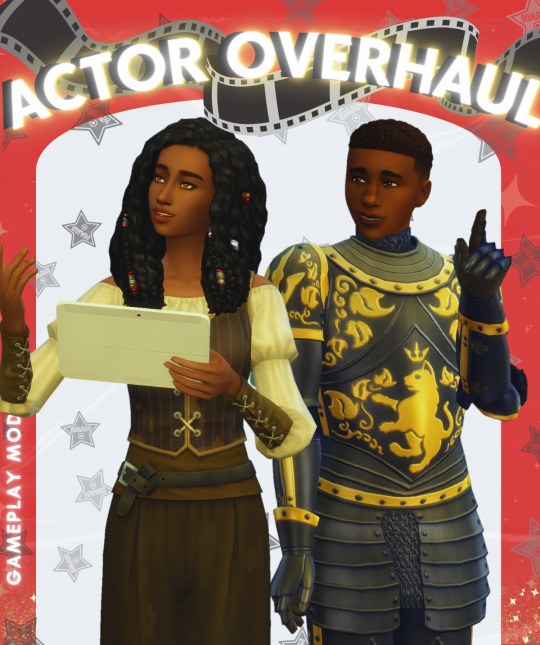
The Actor Overhaul Mod adds some new features to acting in Get Famous. I was super excited about the fact that there was going to be an acting career in the sims, but the career felt a little shallow after replaying it more than once. There wasn't much depth to it and I wanted to add some features that could make it more fun.
What is this mod?
Here are the new additions I have added with the mod.
Actor Dashboard

I have created a dashboard, for actors and aspiring actors. This dashboard will only be available if you have the acting skill. The first option you can choose is Browse Acting Roles. It didn't make sense to me that you could only be an actor, or have gigs if you chose the career. So with this new menu, you can browse through different roles and sometimes make money. Some jobs can also increase your fame and reputation. Other jobs will decrease them.

So with this new menu, you can browse through different roles and sometimes make money. Some jobs can also increase your fame and reputation. Other jobs will decrease them.
The next option is to sign up for the Ward School of Arts Acting Department. This will be in a separate section. Down below.
You can also take Local Acting Classes. This option was made for sims who may already have jobs and do not have a lot of time to focus on acting, but they still do what to increase their acting skill. The local acting classes are evening classes and you need to pay the $100 fee to attend each time.
Preparing Headshot, Acting Resume, and Demo Reel will increase your reputation and give you a boosting career-wise.

One is more expensive than the other. So naturally the result you get from the more expensive one will be better. Once you gather all of those materials you will be able to submit to auditions and casting calls. This will give you more exposure.

Finally, you can now hire an agent. The agent is useful for a lot of things. (If you want to join the EA acting career you will still have to select an agency. I was unable to separate the two.) When you click on the "Find an Agent" option and submit your info, an agent will contact you maybe 24 hours later or more. If you aren't interested in them, simply do not pickup. But if you are press "Ok" on the call. And you will have the option to "Schedule Meeting With Agent" in the 'MB Menu' category.
The agent will come where your sim is located (doesn't have to be at home). These are the interactions you can have with them.
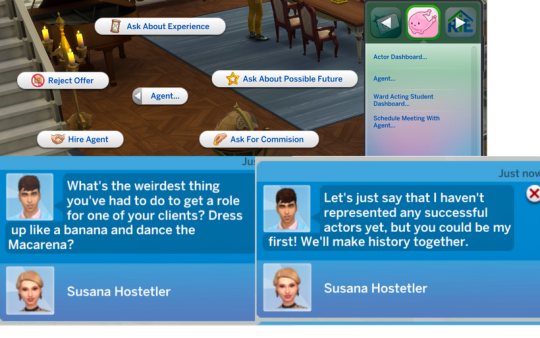
If you want to hire an agent. You can press hire on agent and they will now represent your sim. Keep in mind if you aren't satisfied with their work you can always fire them. There are a few things your agent can do for your sim.

Now circling back to the Acting Student Career:
Your Sim can now join an Acting Student Career. I'd say it's a semi-active career. They do go to the rabbit hole for class, but there are interactions outside of that which make it more interactive.
First of all the first thing you have to do is to go to the 'Actor Dashboard', press on the 'Sign up Option'.

You can press on get info, this will give your sim more information about how to join the school. Once you are ready you can click on 'Audition'. A Ward Student Recruiter will show up. Once they show you MUST choose the 'Start Auditions' option. Don't press on anything else.
This will start an event and there are goals your sim will have to go through. One of the goals, 'Sword Fight'. will require a this object.
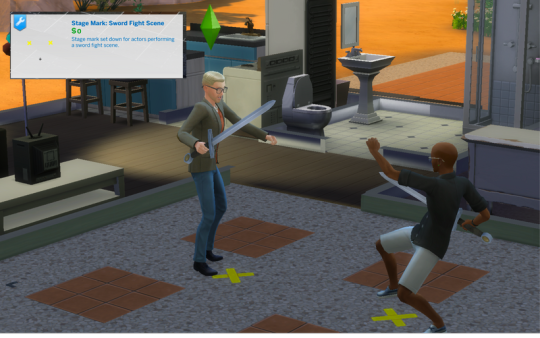
You can find it in BB. If you cannot find it, just look it up in the search bar. Finally, after you complete all of the goals you can cancel the event or wait it out. Once the event is over you will know whether or not your sim is accepted.

If your sim is admitted with a scholarship you can find the job, in the 'Find Job' section. If you are not then try again. But if you have just been admitted you will need to pay the fee first and then you can join.
Once you join the career, each level has a different objective you need to do in order to move on to the next one. In total there are eight levels.
Here are the objectives for each level
- Level 2: Perform in School Production
- Level 3: Submit Paper on the History of theater
- Level 4: Plan and Produce a Production
- Level 5: Volunteer to perform for a charity
- Level 6: Book an acting gig
- Level 7: Get your demo reel, headshot and resume.
- Level 8: Find an Agent.
- All Levels: Pass Term Exam: This is a requirement for all levels. I recommend you do this last for each one of the levels. ESPECIALLY the last one.
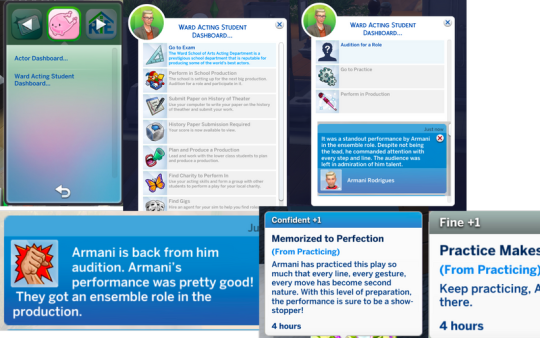
The first activity your sim will have to do is to perform in a school production. The way this happens is your sim will audition for a role first, and depending on how skilled they are they will be assigned a role. When your sim gets a role assigned to them they should go to practice for a while before performing in the production. If they don't practice or don't practice enough they will most likely not do well in production.
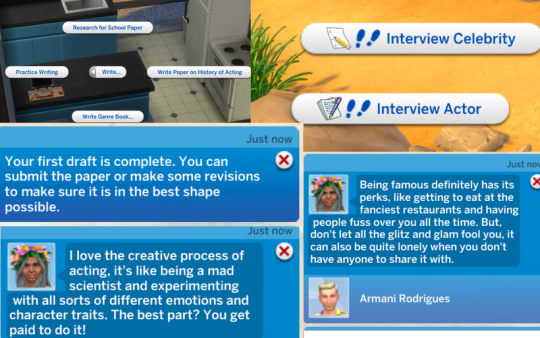
The next step which is "Submit Paper on the History of Theater" will use the computer. In the 'Write' pie menu or your computer will be available. The options that are available for your sim will increase the score they may receive, but it isn't a requirement. You can also interview a celebrity and/or actor for this assignment. It isn't a requirement. Completing this step will give you more points, but it can be hard to complete because if you don't know celebrities it's hard to do this. So doing this will truly impress the professors! Once you are ready submit the paper and then you will be able to view your score once they are released.

Plan and Produce a Production is an objective for Level 4 sims. There are a few things your sim must do to complete this objective. First of all, they have to choose a theme for their production. Then once are ready you can Start the Audition Process.

If you are familiar with my other events mod you may be familiar with the 'Hire this Role'. So for this you will need to invite people or "hire" them to cast roles for the production. Once the event starts your sim will have a few options.

This is an activity and not a timed event so you can take your time to interview sims, and hire them. For the 'Auditioners' you will be able to see them Audition. All you have to do is press on the 'Audition' interaction and then they will start acting. (If you press on the interaction and it doesn't work, click again and it should work)
When you have completed all the required activities you can cancel the event. The game will tell you the event was unsuccessful you can ignore this.
Volunteering to perform for a charity is pretty simple. There is a list of charities your sim will be able to go to. They are each available at different times and days, just select one, go to your performance and the goal will be complete.
The next objectives are objectives we have already gone over. But for Book and Acting there are gigs exclusive to Ward Acting Students.
On the last level, once you Find an Agent, you should then go to your term exam. Passing the exam will make remove your sim from the institution. Being a graduate of this school will increase your rep and fame.
Other Fixes
Aside from the new features I have also made some changes to some already existing features that I found annoying in the game. This file is optional and you will be able to delete it if you do not want it. I have changed the gig payout in the acting career. This way your sim will receive more money when they are higher up in the career. Fame will also decay at a slower rate. This way your sim doesn't constantly have to perform fame activities.

Other Fixes
Aside from the new features I have also made some changes to some already existing features that I found annoying in the game. This file is optional and you will be able to delete it if you do not want it. I have changed the gig payout in the acting career. This way your sim will receive more money when they are higher up in the career. Fame will also decay at a slower rate. This way your sim doesn't constantly have to perform fame activities.
This really took a long time to make but I hope you enjoy it!
What else do I need for the mod?
Lumpinou's Mood Pack: Here
Maplebell Pie Menu: Download Below
Does this mod require any DLC?
Get Famous
Questions and concerns you might have?
Some of this is so inaccurate and doesn't reflect real life.
I tried to do as much research as possible about acting and info about how to get started with it. Some stuff may not mirror real life and that may or may not be intentional.
Will you add more to this?
Yes
I'm experiencing some weird bugs!
Let me know, please.
Report it here: Mod Bug Report
I have different questions about the mod.
If you have questions about something, let me know.
How to install the mod?
Electronic Arts/The Sims 4/Mods <--- Unzip the file and make sure it's placed in this path.
Delete the "maplebell_actingoverhaulfixes(optional).package" if you don't want it.
Public March 26: Download Here
#the sims 4#thesims4#sims 4 mods#the sims cc#ts4#sims 4 edit#ts4cc#sims 4 cc#ts4 mod#ts4 mods#mycc#ts4 download
792 notes
·
View notes
Text
banned from writing scholarship about euripidean tragedy after referring to medea killing her children and flying off in a dragon chariot as a "category 5 girl moment"
2K notes
·
View notes
Text
It's probably time to admit Nico's monaco based youtuber days are over 🥲
in 2023 he only posted 1 video, 8 months ago. In 2022, when he got his rimac his videos popped off among car enthusiasts with over a million views (he was the very first! that's where the monaco based youtuber headline came from lol) and he promised a bunch of stuff he was gonna film with it, like drag racing and 0-1s accelerations but he never did. nicotube was always a passion project, he never did ads or sponsors. in 2017/2018 he was using it to find his post f1 career footing, those videos were more car porn, driving around in fancy sportscars, vlogs of boats or even f1 race vlogs and recaps, starting his own karting team (which kimi antonelli raced in!), and finally dipping his toes into sustainability with greentech festival. he started doing one hour podcast sessions with f1 and then other notable figures, which really popped off during covid. also doing f1 simulator races of every track and talking about the best ways/corners to drive and optimise the track. even tracks he never drove, like he did the sim for Miami in 2022, but not vegas. f1 is ofc his childhood love, he talks about the sport and his career fondly but even that with his sky commentary duties he only attends like 5 races, and no more race vlogs or his driver rankings of the season.
these days, his most used social media is linkedin actually. he's big on tech, startups, and specifically sustainability. esp with Rosberg Philanthropies where he's funding scholarships to phd grads in Oxford who research in sustainability and environmentally friendly tech. so making videos of ferrari car porn doesn't really align with the brand unless it's to promote electric cars.
does that mean his YouTube channel is over? no. I wouldn't be surprised if he drops another video whenever he feels like it, but the olden days of a bunch of sleekly produced videos every other week are long gone. he's moved past it and gotten into other projects he cares about and knowing the rosbergs I wouldn't be surprised if he slowly transitions into more projects where he's not the public facing front of it anymore.
I loved nicotube. i probably wouldn't be as big of a fan if I hadn't discovered it because it allowed a glimpse into nico outside of f1 driver, outside of sky sports narrative, just nico rosberg the person who is genuine in his enthusiasm of explaining how car wings work, who is cringe and funny and endearing and embarrassing. there's some absolute gems there. I'm sad there won't be more but hey, people change and people grow. 🥹 nico especially f1 fandom at large likes to box into unchanging, fixed category, like he was f1 driver til 2016, then monaco youtuber from 2017-♾️, but that's not exactly true and I'm acknowledging one of the changes.
#nico rosberg#I like to think of myself as worlds only nicotube stan I loved those vids#girl who cares? i care 🥹
65 notes
·
View notes
Text
The fabrication of a storm god: Susanoo, Taishakuten (Indra) and their histories

When I found this ask in my inbox recently, I initially admittedly wanted to only give a short, dismissive response. After all, the similarity between these two is completely superficial. And, truth to be told, it’s more a vague similarity between how they are presented as “storm gods” by questionable online sources than between their actual roles. However, I quickly realized that would not accomplish much. The best way to counter misconceptions is to show reality is more interesting - and in the case of complex figures with long histories, this requires time and effort.
The response, like the recent Tamamo no Mae one, kept growing as a result, and evolved into a fully blown unplanned post. Under the cut, you will find a brief examination of the origin of the erroneous notion that Susanoo was ever understood a “storm god”, as well as a summary of his character character, the main deities linked to him in the Japanese “middle ages”, and finally his fate after the Meiji restoration. In the second half, I deal with the Japanese reception of Indra. While not actually related to Susanoo, he is nonetheless a complex deity worth exploring, even though it feels like he’s not particularly appreciated by hobbyists and his central role in medieval cosmology hardly gets acknowledged.
Victorian confabulations and Meiji mirages: the fabrication of a storm god
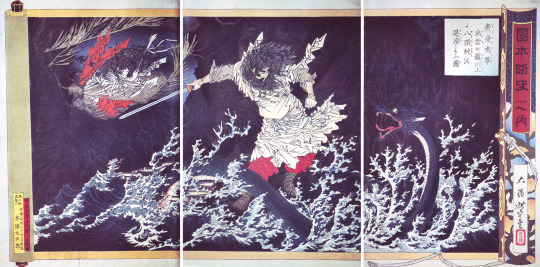
Susanoo vanquishing Yamata no Orochi, as depicted by Yoshitoshi Tsukioka (wikimedia commons)
Contrary to what you might have seen in numerous online sources of dubious quality, Susanoo is not a “storm god” (let alone a “thunder god” more specifically). Nothing to that effect shows up in standard points of reference like Encyclopedia of Shinto, and even Wikipedia despite arbitrarily putting him in the weather god category only musters a single 2000 paper which I’ve never seen cited in subsequent Susanoo research as “evidence” of a weather connection.
The most recent in depth treatments of Susanoo in English are a section of Bernard Faure’s monograph Rage and Ravage and David Weiss’ The God Susanoo and Korea in Japan’s Cultural Memory: Ancient Myths and Modern Empire. The former at no point makes any claims pertaining to the weather while discussing him. The latter notes the view that Susanoo was a “storm god” enjoyed some popularity in the late nineteenth century because of the influence of the now long abandoned school of “nature mythology”, in which deities are only ever representations of natural phenomena. This theory was originally formulated by Edward Burnett Tylor, who basically admitted no actual Japanese sources ever present him as a “storm god”, but that this character is nonetheless evident in his vibes (obviously not how he phrased it, but his study deserves no more dignified summary).
Tylor’s nonsense was subsequently taken up by a certain Edmund Buckle, who randomly connected his forerunner’s oc with Indra because I guess all weather gods are basically interchangeable (there’s an interesting point to be made about how they’re the one group of male deities who are often treated in poor quality scholarship the way goddesses usually are). By 1899, the theory reached Japan, where it caused a prolonged academic debacle. However, it seems supporters of this view, much like in the west, were the followers of the long since abandoned notion of “nature mythology”. Among the theory’s opponents were researchers such as Masaharu Anesaki. As far as I can tell, it’s essentially irrelevant today.
The oldest available information about Susanoo’s actual character comes from the Kojiki and the Nihon Shoki. I don’t think that needs to be discussed here in detail. Even though I often overestimate other people’s familiarity with mythology I think it’s fair to say everyone with just a passing interest in Japan knows at least the basics of the myths about his conflict with his sister Amaterasu, his banishment, and subsequent victory over the serpent Yamata no Orochi. It will suffice to say the oldest recorded mythical image of him is that of an ambivalent deity, a heroic monster slayer on one hand, a transgressor and exile on the other. This polarity remains a core part of him for the rest of his history.
The other early sources dealing with Susanoo are various fudoki, regional records. They indicate that in the eighth century he already was connected with diseases. Later on in the Heian period, he also came to be associated with purification. Or to be more precise - he came to be viewed as the archetypal target of purification, in a way. His misdeeds from classical mythology became examples of deeds requiring such ceremonies, performed variously by courtly ritual specialists like the Nakatomi clan, Buddhist clergy, or onmyōdō masters. He also functioned as a jinushi, a “landholder deity” of often ambivalent character tied to a specific location, and an araburugami, a “raging god” defined by causing havoc out of hubris (as opposed to malice).
Gozu Tennō and others: the network of medieval Susanoo
Susanoo’s character developed through the Japanese “middle ages” in no small part through associations with other deities, typically caused by his incorporation into Buddhism.

A composite Susanoo-Gozu Tennō, as depicted by Sadahide Utagawa (Östasiatiska Museet, Stockholm)
The single most important figure he came to be linked with was by far Gozu Tennō, the “Bull-Headed Heavenly King”. While religious and literary texts present him as a deity from India, the guardian of the Jetavana monastery, and he was even furnished with an artificial Sanskrit name, Gomagriva Devaraja, his origin is actually uncertain. It’s possible he was inspired by a misreading of a passage from the travelog of the Chinese monk Faxian (c. 337-442). He visited Jetavana in the early fifth century, and reported that there was a statue of a bull next to the monastery’s door, before moving on to describing the supposed first image of the Buddha, which according to him was made from legendary “ox-head sandalwood” and impervious to fire. Confusion between these two passages might have led to the creation of an ox-headed deity. Other proposals are present in scholarship too, but ultimately the matter remains unclear.
What is evident is that Susanoo and Gozu Tennō shared many similarities: the latter also was an archetypal “raging deity”, and he too was linked with pestilence. An argument can be made that he was the disease spirit par excellence in medieval Japan, in fact. When properly worshiped, he was supposed to protect the faithful from illnesses, as expected from a deity of this variety. They also shared an association with foreign lands: Gozu Tennō primarily with India, but also with China and Korea, while Susanoo just with Korea, due to a Nihon Shoki episode where he travels to the kingdom of Silla. Yet another point of connection is that both were simultaneously recognized as manifestations of Yakushi (the “medicine Buddha”). Therefore, it comes as no surprise that at the Gion shrine in Kyoto, and in many other locations across Japan, the two were identified fully.
However, the link was at times conceptualized differently than as interchangeability between the two. For instance, Kaneyoshi Ichijō’s treatise Kuji Kongen (公事根源; “Roots of Court Administration and Ceremonies”) Gozu Tennō is merely an “acolyte” (warawabe, 童部) of Susanoo. Granted, this author eventually came to view them as identical himself, which shows how fluid medieval theology could be.
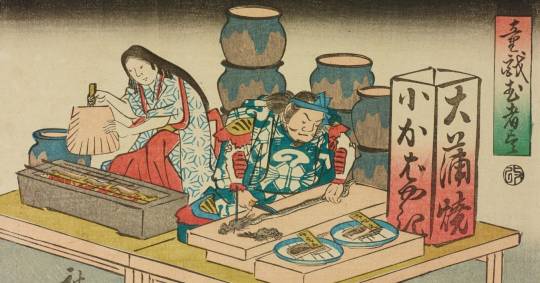
A humorous depiction of Susanoo and Kushinadahime serving pieces of Yamata no Orochi prepared like grilled eel (Ōta Memorial Museum of Art; reproduced here for educational purposes only)
The identification between Susanoo and Gozu Tennō also extended to their wives, respectively Kushinadahime and Harisaijo (波梨采女), as evident for example in the Shaku Nihongi. The latter was regarded as a daughter of the dragon king Sāgara. Things are made slightly awkward by the Nihon Shoki Sanso, where she is a manifestation of Yamata no Orochi (one of the multiple cases of putting a positive spin on the snake). Susanoo in the guise of Gozu Tennō thus effectively marries his nemesis.
The marriage itself is a subject of a number of myths. According to Hoki Naiden (簠簋内伝), an onmyōdō manual, the “heavenly emperor” (Taishakuten, one would presume, based on information I’ll discuss later) de facto played the role of a matchmaker between Harisaijo and Gozu Tennō. When the latter was lamenting that due to his monstrous, yaksha-like form - he had the head of a bull - he will never find love, a bird sent by the celestial ruler informed him that it would be appropriate for him and Sāgara’s daughter to get married. This suggestion then evidently works out just fine, and the couple subsequently have eight children, the Hachiōji (八王子, “eight princes”) over the course of thirty seven years.
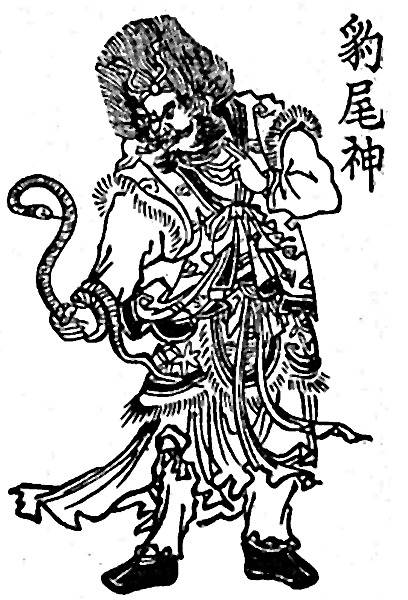
Hyōbi (wikimedia commons)
There are multiple slightly divergent traditions about the identities of the children. The most notable variable is that a goddess named Jadokkeshin (蛇毒気神; also read Dadokuke no kami; “deity of poisonous snake breath”) sometimes appears among them, sometimes is treated as an independent deity serving Gozu Tennō, and sometimes takes the role of his spouse (in at least one case with Harisaijo quite literally relegated to the role of his ex). She is also identified with the astral deity Hyōbi (豹尾, “leopard tail”) and by extension with Ketu.
Another figure who was closely linked with Susanoo in the middle ages was Matarajin. This tradition was associated with Gakuen-ji. In a local legend, Susanoo started to be called Matarajin after being buried underneath it. I won’t dwell much on Matarajin here since I already wrote a lot about him, and will write even more in the near future, so it will suffice to say the two share a connection to diseases. In Matarajin’s case it is the most pronounced in the “ox festival” still held in modern times at Kōryū-ji.

Shinra Myōjin (wikimedia commons)
Connections between Susanoo and Matarajin’s fellow Tendai old man disease-related deities Sekizan Myōjin and Shinra Myōjin are documented too. Bernard Faure argues that in fact it was Shinra Myōjin who first developed such an association, and it was only transferred to Matarajin as well because of the numerous analogies between them.
A distinct tradition regarding Susanoo developed in the theology of Ise (“Ryōbu shintō”), which as expected was Amaterasu-centric (but also Dainichi-centric!). He came to be linked with Mara and Devadatta as a representation of “fundamental ignorance”, with the conflict between him and Amaterasy gaining an additional Buddhist dimension. At the same time, in the noh play Dairokuten (第六天), which deals with Jōkei’s pilgrimage to Ise, Susanoo appears to protect this monk from Mara. Evidently, in this context Susanoo and Amaterasu are hardly opposed to each other, seeing as the former de facto intervenes on behalf of the latter.
While the notion of rivalry between the siblings obviously did not vanish in the middle ages, and in fact new myths about it started to circulate (in one Matarajin assists Susanoo), it can be argued that it was ultimately the new conflict between Amaterasu and Mara that was central to many medieval theologies. While she and Susanoo could be portrayed as antagonistic, there is a case to be made that there were more similarities between medieval ideas about them than there were differences. That was not meant to last, though.
Later developments
The tradition of associating Susanoo with assorted medieval deities first came under criticism in the eighteenth century. Sadakage Amano, an early proponent of kokugaku ("national learning", an early Japanese nationalist ideology) ideas, wrote a treatise dealing with this matter, Gozu Tennō Ben (牛頭天王辨, “Clarification on Gozu Tennō”). Its core premise is that monks and shrine priests alike are deceptively trying to present “foreign” deities as identical with “native” ones. This point was further developed in the nineteenth century by another kokugaku big name, Atsutane Hirata.

Hirata's self portrait (wikimedia commons)
He reaffirmed that presenting Susanoo and Gozu Tennō as related deities was a nefarious plot, and blamed Kibi no Makibi for starting it. He argued that Makibi spent too much time in China and as a result forsake a pristinely Japanese way of thinking (whatever that wouldn't entail). As a result, when he heard the legend of ox-head sandalwood, which was believed to grow on the mythical continent Uttarakuru and cure diseases, he turned it into a deity, who he subsequently brought to Japan. Then he identified him with Susanoo to increase his prestige.
Was that the historical truth? Kibi no Makibi was an envoy to China and spent around 20 years on the mainland, that much is undeniable. However, the only connection between him and Gozu Tennō I was able to track down is a local legend pertaining to Mount Hiromine in which he meets this deity in a dream, though.
Ultimately like most of Hirata’s writing, his theory consists virtually entirely of confabulations, mostly motivated by extreme levels of xenophobia. Rather ironic for a movement which originally largely developed among the most hardcore neo-Confucian thinkers in Japan. Granted, that’s hardly the only baffling thing about them. The best way to understand what was going on in the heads of kokugaku proponents is to recall how contemporary marble bust profile pic “the west has fallen” trads or Bible literalist creationists function, and adjust that image for the specifics of the Edo period.
Still, kokugaku theories, nonsensical as they were, kept developing, and finally gained government support after the Meiji revolution. In 1868, the Council of State proclaimed that shrines can no longer use “inappropriate” names to refer to their deities. Gozu Tennō was the only example brought up directly, in part possibly because with the reestablishment of the power of the emperor and the rise of the imperial cult it was viewed as suspicious that a deity unrelated to the imperial court had the moniker of tennō (written with different signs, though). The edict also contains a blanket ban on any name with the element gongen.
As a result of the new policies numerous locations had to be renamed, and for the most part the history of Gozu Tennō came to an end. He and his peers eventually came back into the spotlight in the second half of the twentieth century as subjects of scholarly inquiries, and the field of study of medieval and early modern Japanese religions is now booming, with entire monographs and articles published in multiple languages each year, but that’s another story.
The history of Susanoo obviously did not end in the 1860s, though. What followed was probably the single darkest page in it, an era of intense efforts to make him identical with Dangun, the legendary founder of Korea. The goal was explicitly to justify Japanese colonial control over Korea through faux-spiritual means. Since Japanese colonial domination of Korea is a relatively recent and deeply serious historical issue compared to what I cover most of the time, I feel it would be inappropriate to deal with it in the same article as medieval literature which ultimately lacks much of a tangible impact on the modern world, so I hope you won’t mind I don’t go deeper into the detail here.
With the matter of Susanoo now settled, let’s move on to Indra. The two were never associated with each other, but the latter developed an equally vibrant network of roles and associated deities around him as Susanoo after being transmitted to Japan.
From Indra to Taishakuten

A typical Hindu depiction of thousand-eyed Indra (wikimedia commons)
Indra has a long and complex history, so long he is in fact attested a handful of times in bronze age cuneiform already as one of the notoriously mysterious non-Hurrian Mitanni deities (sic), invoked as personal deities of the royal house in a lengthy treaty oath. This makes him one of the very few “bridges” between my two major normally disconnected interests (the “cuneiform world” on one hand, and East Asian religions and art on the other).
The biggest early text corpus dealing with Indra are the Vedas, where he is the single most frequently mentioned deity, with quite literally hundreds of hymns praising him. Naturally, he remained a part of the history of Hinduism later on, and today he is still well known thanks to his role in popular epics like Ramayana. His relevance is not limited to this system of beliefs alone, though. He has a small (negative) role in the Avesta (see here), and he was embraced by various schools of Buddhism across much of Asia.
In early Buddhism, the prestige of Indra was not particularly great. This obviously reflects the fact that the formative years of Buddhism were also a period of Indra’s relative decline as an actively worshiped god back at home at the expense of deities central in contemporary Hinduism like Vishnu and Shiva. However, he surprisingly regained some of his original prestige thanks to developments which occurred outside of India. This is well documented in East Asia in particular. I’ll only cover his Japanese reception here - therefore, through most of the rest of the article I will use his Japanese name, Taishakuten (帝釈天), accordingly.
Buddhism emphasizes not Indra’s warlike side and his battles with asuras, let alone a connection with the weather, but rather his role as a heavenly ruler. He keeps epithets related to his 1000 eyes, but to the best of my knowledge this is not really reflected in Buddhist art, especially not in Japan. Another role retained by him in Buddhism is that of a directional deity, the protector of the east.
Something that’s worth highlighting is that asuras in general just aren’t that big of a deal in Japanese Buddhism. Outside of enumerations of non-human sentient beings, only Rahu and Ketu have a substantial role, and that’s more because they’re astral deities rather than because they’re asuras. Otherwise the entire category is about as opaque as mahoragas (when you look up “mahoraga” online 99% results are a Jujutsu Kaisen character, as it turns out, which speaks volumes about their general obscurity) and the like. Hard to make opposition to them the focus of a major deity when even gandharvas have a bigger role to play.
I can only think of a handful of major references to battles between Taishakuten and asuras in Japanese literature: an offhand comment in Heike Monogatari (courtesy of Kenreimon-in), a passage from the Taiheiki where Jōkei (who you already met earlier in this article) has the privilege to watch the parties involved reenact the conflict for his benefit, and a myth cited by Annen with no source provided, possibly invented by him. The innovation is that Marici (Marishiten) is a major combatant on the side of the devas, something with no parallel in any other source, whether Buddhist or Hindu. Rahu is singled out among the asuras as an enemy of Taishakuten, but that’s hardly unparalleled.
The conventional image of Taishakuten
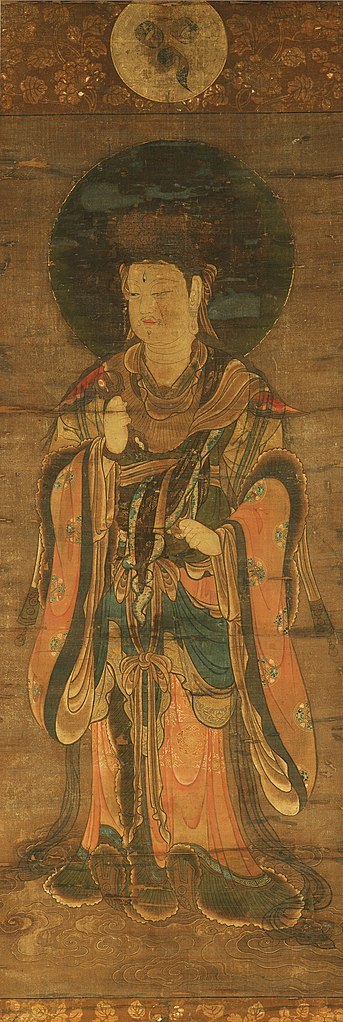
A conventional depiction of Taishakuten (wikimedia commons)
For the average Japanese person through much of the country’s history, the most frequent exposure to Taishakuten were standardized oath formulas (kishōmon). These followed a strict hierarchy of deities: Taishakuten, Bonten (Brahma) and the four heavenly kings first, then king Enma, Godo Daishin (Wudao Dashen), Taizan Fukun and other underworld officials (sometimes assisted by astral figures), then kami and representations of Buddhas tied to specific localities (for example the great Buddha of Tōdai-ji), and sometimes various religiously significant historical figures like prince Shotoku or Buddhist patriarchs. Obviously, Taishakuten’s elevated position reflects his role as a heavenly ruler - the “heavenly emperor”, tentei (天帝).
The residence of Taishakuten is the heaven of the thirty three devas (忉利天, Tōriten, a calque from Sanskrit Trāyastriṃśa). It is located on Mount Sumeru, the center of the world according to Buddhist cosmology. Sources from the Heian period indicate the existence of a belief Taishakuten’s heaven is unique in that women could be reborn in it after death without first reincarnating as men. This distinction was otherwise only attributed to the pure land of Maitreya. Note it was not Taishakuten himself who was responsible for guaranteeing that, though, but rather the bodhisattva Fugen, who was particularly popular among Heian court ladies.
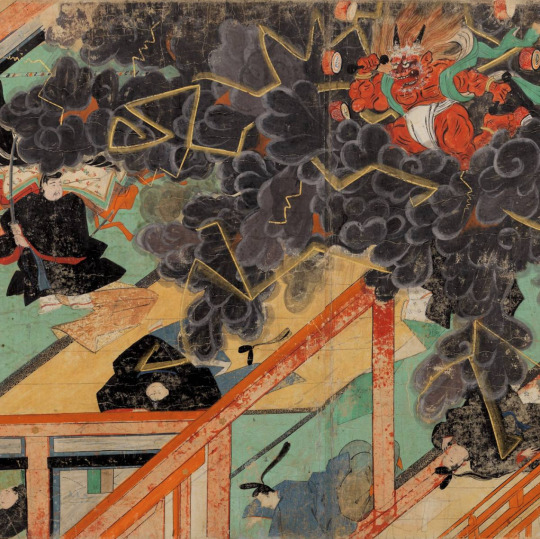
Karai Tenjin (wikimedia commons)
Taishakuiten’s major position in the Buddhist-influenced cosmos is also evident in literary compositions focused on other deities. For example, in the Dōken Shōnin Meidoki (道賢上人冥途記, “Record of Dōken Shōnin’s Experience of the Other World”), a version of the legend of Michizane, his revenge is supported by Taishakuten, who gives him a new name, Nihon Dajō Itoku Ten (日本太政威徳天). This is meant to show his banishment was a religious transgression, and we also learn that the emperor responsible for it, Daigo, fell into hell as a result. However, esoteric Buddhism is also credited with calming Michizane down - as he explains himself, “bodhisattvas (...) were there, and they enthusiastically propagated the esoteric teachings. Because I liked these teachings very much, one-tenth of my deeply seated enmity from my past was reduced.”
This obviously goes against the more common legend where being enshrined pacifies Michizabe entirely. In the Dōken version he announces that the enshrined deity, who he calls Karai Taiki Dokuō (火雷大気毒王; “King of Fire-Thunder and Poisonous Air”), is merely his messenger #3 (#1 and #2 are not mentioned).
The closest thing I can think of to Taishakuten being associated with the weather in Japanese sources occurs in a version of the Michizane legend, too: in another variant, Michizane states it was Taishakuten alone who permitted him to enact his vengeance and entrusted him with commanding 105000 thunder gods (in the Dōken Shōnin Meidoki there are 168000 attendants instead, “poisonous dragons, evil demons, deities of water and fire, thunder and lightning, the director of the wind, the master of the rain, and other poisonous, harmful, and evil deities”) and causing disasters.
From emperor to heaven to controller of fate
Due to his prominent cosmological role Taishakuten is also described in many sources as a controller of fate responsible for determining the lifespans of living beings. Sometimes, in this capacity he basically overlaps with king Enma - for example, Shishi Yaloan, a Buddhist encyclopedia from the eleventh century, states that he also possesses a mirror in which he can check on his subjects. A local tradition from Tateyama states that he lives on the Taishaku Peak of Mt. Tate, simultaneously regarded as an entrance to Buddhist hell. However, while Enma and the other kings of hell generally stay there, Taishakuten takes a more proactive role, seeking information about the good and bad deeds of the living. Initially, it was believed that a survey of the whole world was conducted on his behalf by the four heavenly kings, but by the tenth century, a belief that he performs it himself every four months himself developed.

The famously unconventional depiction of Taishakuten from Shibamata Taishakuten, still distributed today in the form of ofuda (wikimedia commons)
In the Edo period, Taishakuten as a controller of fate developed a connection with deities associated with the tradition of kōshin nights. In this context he became the deity the three worms living in every person’s body report their good and bad deeds to. Temples associated with him, like Shibamata Taishakuten (famous among other things for its unconventional images of the eponymous deity), were historically a popular destination for pilgrimages tied to kōshin celebrations.
While the fate connection ultimately came to the forefront in Japan, it would be unfair to say it entirely superseded the original heavenly role. As a matter of fact, it was the fact that Taishakuten was a “heavenly emperor” (tentei) that made him such a good fit for kōshin.
The elusive "emissary of Taishaku"
As early as in the Muromachi period, yet another deity came to be viewed as responsible for Taishakuten's survey of the world in a variant tradition: one of the so-called “ambulatory deities” (遊行神, yugyōjin; “ambulatory” as in “wandering”, not in the medical sense) , Ten’ichi(jin) (天一神; also read Nakagami), literally “the first deity of heaven”. He was regarded as a “vassal” of Taishakuten and the commander of the Twelve Heavenly Generals. Each of his cyclical surveys of the world lasted 44 days (four times five days for each of the main directions and then four times six for the intermediate ones). That was followed by sixteen days during which he reported the vices and virtues he recorded to Taishakuten in heaven, with his own underling Nichiyū(jin) (日遊神; “playing sun deity”) descending to earth instead.
During Tenichi’s absence, which started with a day referred to as Ten’ichi tenjō (天一天上), directional taboos pertaining to various astral deities, which normally had to be countered with a practice known as “changing directions” (方違え, katatagae), did not apply.
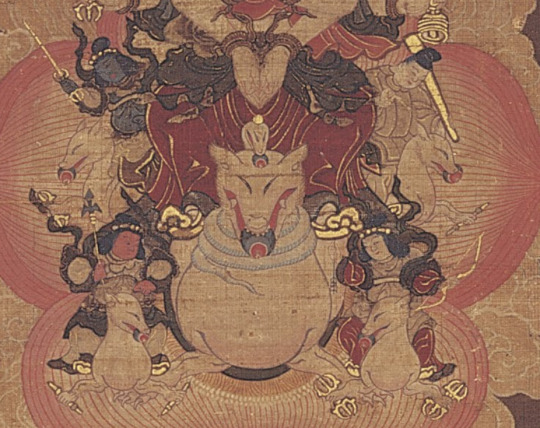
Taishaku Shisha (top right) and his peers accompanying Dakiniten (wikimedia commons)
Another interesting thing about Ten’ichi is that he was identified with an elusive deity known simply as Taishaku Shisha (帝釈使者), literally “emissary of Taishaku”. At first glance this doesn’t really sound interesting - after all, Taishaku Shisha’s name sounds exactly like what Ten’ichi does - but completely unexpectedly, the former actually belongs to the entourage of Dakiniten. His attributes make him resemble officials of the underworld, though he is never portrayed as menacing, always as benign, and his duty is to report the good and bad deeds to his superiors, much like Ten’ichi does. He additionally functions as a god of wisdom, which according to Bernard Faure might reflect Dakiniten’s link to the bodhisattva Monju, famous due to an association with this concept.
Curiously, while Taishaku Shisha is at least nominally a member of a group of four “acolytes” of Dakiniten alongside Tennyoshi (天女子; “heavenly maiden”; holds a bow), Shakunyoshi (赤女子; “red maiden”; holds a halberd and a “seduction jewel”, aikei-gyoku, 愛敬玉) and Kokunyoshi (黒女子; “black maiden”; holds a sword and a black jewel), he is sometimes described as de facto separate from them. Perhaps the fact his very name links him with another deity has something to do with that. Also, he is absent from the origin myth of the three maidens, who according to Hoki Naiden flew to Japan from India. According to Bernard Faure, it is possible his roles overlapped in part with Dakiniten’s own emissaries, the tengu Tonyūgyō (頓遊行; brings happiness) and Suyochisō (須臾馳走; brings longevity).
Dakiniten, “demon kings” and Amaterasu: the network of Taishakuten
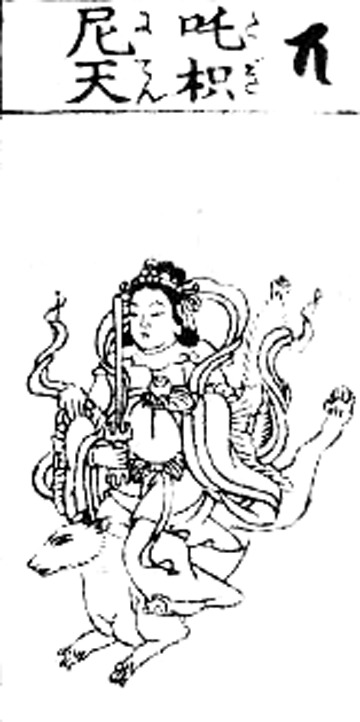
Dakiniten (wikimedia commons)
Taishakuten’s connection with Dakiniten goes beyond the figure of Taishaku Shisa. The Mizōukyo (未曽有經) contains a myth according to which a fox once tricked Indra into accepting the animal as his master is recorded. It serves as an explanation for the notably fox-like Dakiniten’s elevated role in the royal ascension rite devised by Shingon priests (it was still performed in the 19th century, emperor Meiji was the first to abstain from it). In folk beliefs Taishakuten was also sometimes assigned the role of the “master of the foxes”, which normally belonged to her instead.
The link to these animals according to Bernard Faure might have reflected a more ambivalent perception of Taishakuten than usually expected. The other possible piece of evidence in favor of this interpretation is a poem which proclaims that he and Tsuno Daishi, the demonic manifestation of Ryōgen, look “like brothers”. The latter is a complex figure, but it will suffice to say here that historically he was sometimes perceived as a “demon king” (魔王, maō). On the other hand, the original holder of this title, the “Demon King of the Sixth Heaven” (in other words, Mara) was said to offer his blood to Taishakuten on “blood-shunning days” (地幅, chi-imbi). In practical terms, this meant a religious prohibition on the drawing of blood, acupuncture and moxibustion on a specific day, different each month.
I need to stress here that even though figures such as Dakiniten and the “demon kings” obviously originated in the realm of demonology - respectively as a flesh-eating, vital essence-stealing demon and as the tempter of the Buddha - they eventually developed much more complex and nuanced characters. Therefore, it is not unexpected major deities appear in association with them. In the middle ages, even Amaterasu was frequently linked with them.
Funnily enough, in contrast with Susanoo Amaterasu does have a connection to Taishakuten as well. Tenshō Daijin Kuketsu (天照大神口決; “Oral Transmission.Pertaining to the Great Goddess Amaterasu”) from 1328 states that she corresponds to him - but also to Bonten, Shōten (Ganesha), the kushōjin (倶生神; these would take a bit to explain), king Enma and Godō Daijin. Granted, another roughly contemporary treatise, Reikiki, instead proclaims Taishakuten, the “heavenly emperor” (tentei; just like in the later kōshin tradition) the “kami-body” of Toyouke, the outer shrine Ise deity. However, these matters ultimately go beyond the scope of this response. Stay tuned for my article about medieval Amaterasu to find out more!
Bibliography
Ryūichi Abe, Women and the “Heike Nōkyō”: the Dragon Princess, the Jewel and the Buddha
Bernard Faure, The Fluid Pantheon (Gods of Medieval Japan vol. 1)
Idem, Protectors and Predators (Gods of Medieval Japan vol. 2)
Idem, Rage and Ravage (Gods of Medieval Japan vol. 3)
Gerald Gromer, A Year in Seventeenth-Century Kyoto. Edo-Period Writings on Annual Ceremonies, Festivals, and Customs
Takuya Hino, The Daoist Facet of Kinpusen and Sugawara no Michizane Worship in the Dōken Shōnin Meidoki: A Translation of the Dōken Shōnin Meidoki
Nobumi Iyanaga, Medieval Shintō as a Form of 'Japanese Hinduism': An Attempt at Understanding Early Medieval Shintō
William Lindsey, Religion and the Good Life: Motivation, Myth, and Metaphor in a Tokugawa Female Lifestyle Guide
Fabio Rambelli, Before the First Buddha: Medieval Japanese Cosmogony and the Quest for the Primeval Kami
Hiroo Satō, Wrathful Deities and Saving Deities in: Fabio Rambelli and Mark Teeuwen (eds.), Buddhas and Kami in Japan. Honji Suijaku as a Combinatory Paradigm
Idem, The Emergence of Shinkoku (Land of the Gods) Ideology in Japan in: Henk Blezer and Mark Teeuwen (eds.), Challenging Paradigms. Buddhism and Nativism: Framing Identity Discourse in Buddhist Environments
David Weiss, The God Susanoo and Korea in Japan’s Cultural Memory: Ancient Myths and Modern Empire.
84 notes
·
View notes